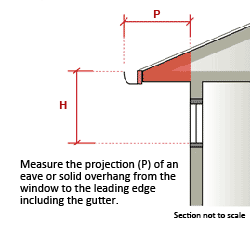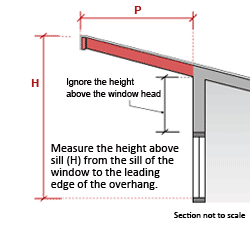Eave, balcony, porch and verandah projections are measured to the outside edge of the feature including any fixed attachment such as a gutter. For example, if your roofing truss overhangs by 450mm and you have a standard 25mm fascia and 125mm gutter, then select 600mm projection. Measure projection to the face of the wall in which the window is located.
Note: Shading with an external permanent projection must extend horizontally on both sides of the window or glazed door for a distance not less than the projection (P).
A shading projection that is less than 500mm above the window head (e.g. eave) will typically provide reasonable shading whereas a projection that is higher (e.g. skillion roof) will allow more sun to hit the window and will be less effective. For Alterations and Additions, projections must be no more than 500mm above the window head and no more than 2400mm above the sill.
If a shading projection does not meet the above criteria, you may be able to use the projection/height above sill ratio. To calculate the ratio, measure the projection (P) of an eave or solid overhang from the window to the leading edge including the gutter, and measure the height (H) from the sill of the window to the leading edge. Be sure to use the same units. The projection/height above sill ratio equals the projection (P) divided by the height above the sill (H).
Tip: The projection/height above sill ratio may be more suitable for small windows or for windows where H is small.

Measure the projection (P) of an eave or solid overhang from the window to the leading edge including the gutter

Measure the height above sill (H) from the sill of the window to the leading edge of the overhang